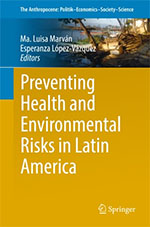APESS
Vol 23 |
Ma. Luisa Marván, Esperanza López-Vázquez (Eds.): Preventing Health and Environmental Risks in Latin America (Cham: Springer International Publishing, 2018).
ISBN: 978-3-319-73798-0 (Softcover)
ISBN: 978-3-319-73799-7 (EBook)
Doi: 10.1007/978-3-319-73799-7 (add chapter no.)
Order this book on Springer Website
|

|
- Approaches various health and environmental risks from different disciplines in a language understandable to all readers
- Discusses several diseases that are a consequence of bad habits of people and, therefore, easy to prevent
- Discusses several environmental issues that have been little studied and are the basis of many serious disasters • Focuses on Latin America
This book addresses several risks that could affect our well-being, our health, or even cause death. Some of the issues analysed could have negative consequences not only today but also for future generations if not prevented in time. With regard to health risks, the authors discuss several diseases that could be avoided if people perform (or avoid) certain behaviours and become accustomed to having healthier habits. Concerning environmental hazards, the authors discuss which social groups should be taken into account based on preventive strategies used to avoid a particular disaster. Both sections of the book on health and environmental issues have a subsection with chapters about risks and society. No matter the risk-related discipline the reader is familiar with, after reading the book, it will become clear that risk analysis is the basis for prevention, and that it cannot be addressed from a single discipline or with a single methodology. |